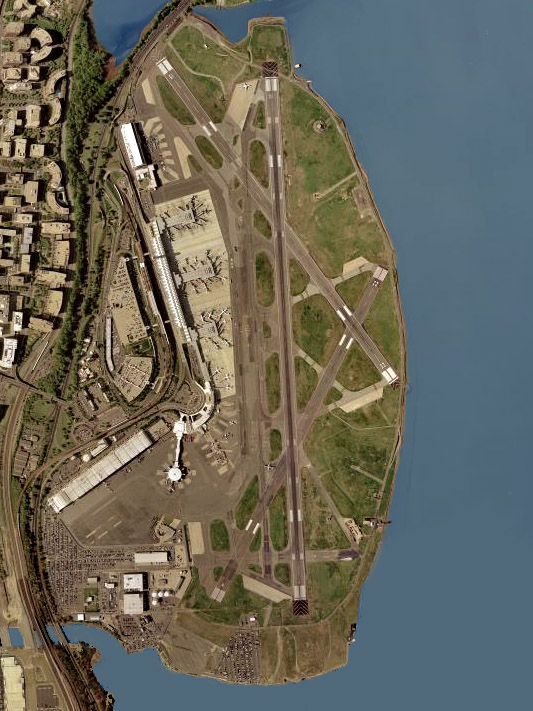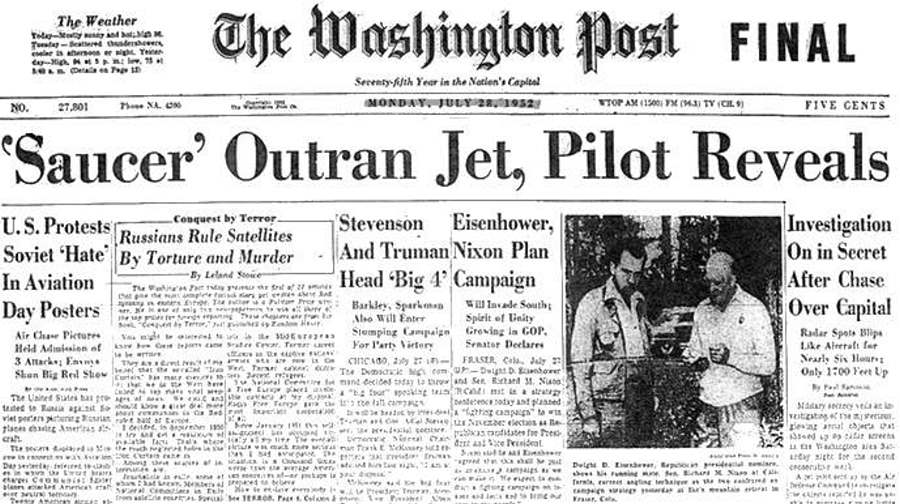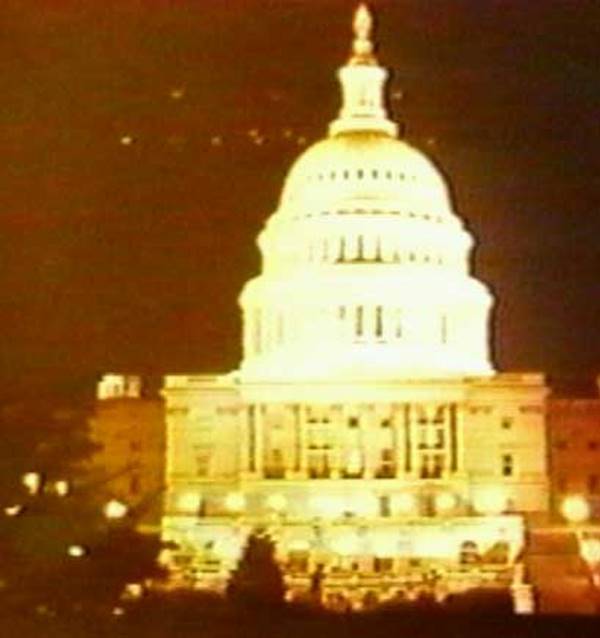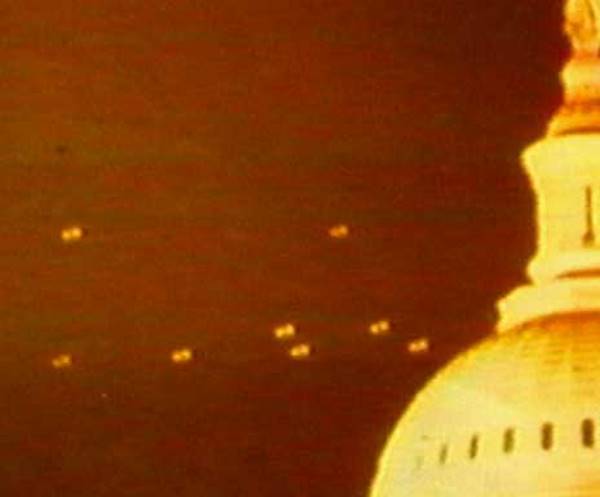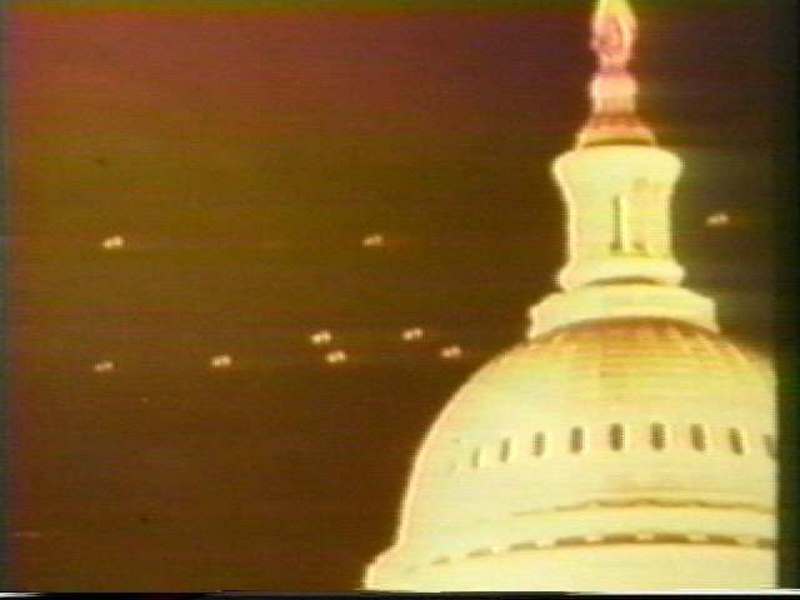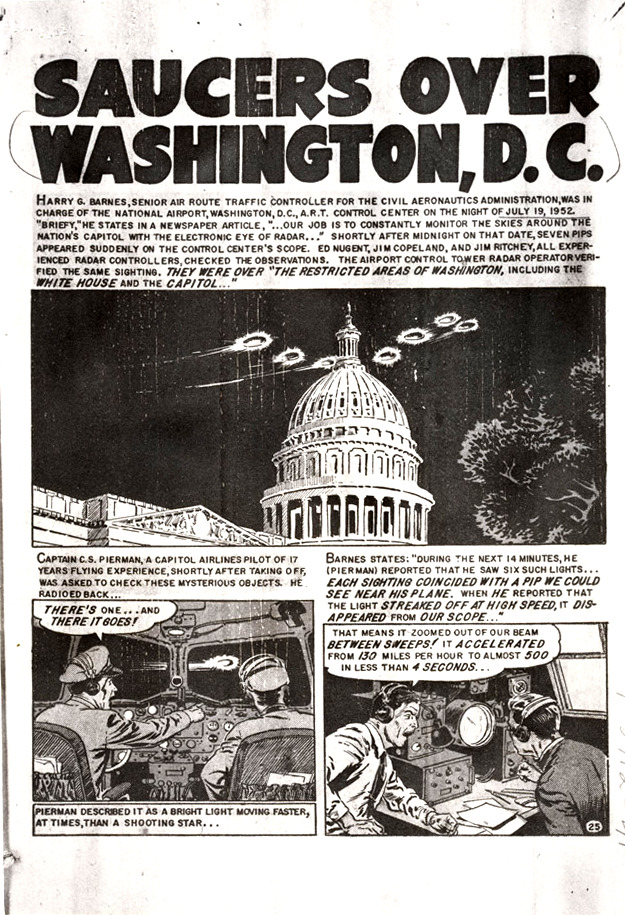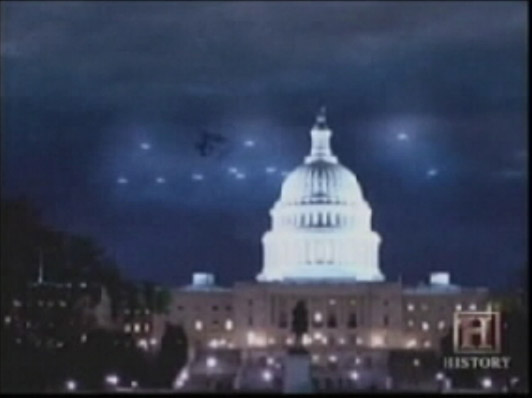|
The UFO Files |
||||||||
|
..
1952 Washington D.C. UFO incident The 1952
Washington D.C. UFO incident, also known
as the Washington flap or the Washington National
Airport Sightings, was
a series of unidentified flying object reports
from July 12 to July 29,
1952, over Washington D.C. The most publicized
sightings took place on
consecutive weekends, July 19–20 and July 26–27.
Longtime ufologistRichard H. Hall, who served as the assistant director of NICAP and as the director of the Fund for UFO Research, writes:[1]
At 11:40 p.m. on Saturday,
July 19, 1952, Edward Nugent,
an air-traffic controller at Washington
National Airport, spotted seven
objects on his radar. The objects were located
15 miles south-southwest
of the city; no known aircraft were in the
area and the objects were not
following any established flight paths.
Nugent's superior, Harry Barnes,
a senior air-traffic controller at the
airport, watched the objects on
Nugent's radarscope. He later wrote;
"a bright orange light. I can't tell what's behind it" (Clark, 653).At this point, other objects appeared in all sectors of the radarscope; when they moved over the White House and the United States Capitol, Barnes called Andrews Air Force Base, located 10 miles from National Airport. Although Andrews reported that they had no unusual objects on their radar, an airman soon called the base's control tower to report the sighting of a strange object. Airman William Brady, who was in the tower, then saw an "object which appeared to be like an orange ball of fire, trailing a tail . . . [it was] unlike anything I had ever seen before." As Brady tried to alert the other personnel in the tower, the strange object "took off at an unbelievable speed" and vanished in "a split second". He then observed a second, similar object, but it also disappeared before anyone else in the tower could see it (Clark, 654). At 12:30 a.m. on July 20, another person in the National Airport control tower reported seeing "an orange disk about 3,000 feet altitude". On one of the airport's runways, S.C. Pierman, a Capital Airlines pilot, was waiting in the cockpit of his DC-4 for permission to take off. After spotting what he believed to be a meteor, he was told that the control tower's radar had picked up unknown objects closing in on his position. Pierman observed six objects — "white, tailless, fast-moving lights" — over a 14-minute period (Clark, 655). Pierman was in radio contact with Barnes during his sighting, and Barnes later related that "each sighting coincided with a pip we could see near his plane. When he reported that the light streaked off at a high speed, it disappeared on our scope." At Andrews AFB, meanwhile, the control tower personnel were tracking on radar what some thought to be unknown objects, but others suspected, and in one instance were able to prove, were simply stars and meteors. However, Staff Sgt. Charles Davenport observed an orange-red light to the south; the light "would appear to stand still, then make an abrupt change in direction and altitude . . . this happened several times" (Clark, 655). At one point both radar centers at National Airport and the radar at Andrews AFB were tracking an object hovering over a radio beacon. The object vanished in all three radar centers at the same time (Ruppelt, p. 160). At 3 a.m., shortly before two jet fighters from Newcastle AFB in Delaware arrived over Washington, all of the objects vanished from the radar at National Airport. However, when the jets ran low on fuel and left, the objects returned, which convinced Barnes that "the UFOs were monitoring radio traffic and behaving accordingly" (Clark, 656). The objects were last detected by radar at 5:30 a.m. Around sunrise, E.W. Chambers, a civilian radio engineer in Washington's suburbs, observed "five huge disks circling in a loose formation. They tilted upward and left on a steep ascent."
Publicity and Air Force reaction The sightings of July 19–20, 1952, made front-page headlines in newspapers around the nation. A typical example was the headline from the Cedar Rapids Gazette in Iowa. It read "SAUCERS SWARM OVER CAPITAL" in large black type (Michaels, p. 22). By coincidence, USAF Captain Edward J. Ruppelt, the supervisor of the Air Force's Project Blue Book investigation into the UFO mystery, was in Washington at the time. However, he did not learn about the sightings until Tuesday, July 22, when he read the headlines in a Washington-area newspaper. After talking with intelligence officers at The Pentagon about the sightings, Ruppelt spent several hours trying to obtain a staff car to investigate the sightings, but was refused as only generals and senior colonels could use staff cars. He was told that he could rent a taxicab with his own money; by this point Ruppelt was so frustrated that he left Washington and flew back to Blue Book's headquarters at Wright-Patterson AFB in Ohio (Ruppelt, 162). Before leaving Washington, Ruppelt did speak with an Air Force radar specialist, Captain Roy James, who felt that unusual weather conditions could have caused the unknown radar targets (Ruppelt, 163).
Events of July 26–27 At 8:15 p.m. on Saturday, July 26, 1952, a pilot and stewardess on a National Airlines flight into Washington observed some strange objects above their plane. Within minutes, both radar centers at National Airport, and the radar at Andrews AFB, were tracking more unknown objects. A master sergeant at Andrews visually observed the objects; he later said that "these lights did not have the characteristics of shooting stars. There was [sic] no trails . . . they traveled faster than any shooting star I have ever seen" (Clark, 658). Meanwhile, Albert M. Chop, the press spokesman for Project Blue Book, arrived at National Airport and refused several reporters' requests to photograph the radar screens. He then joined the radar center personnel (Ruppelt, 164). By this time (9:30 p.m.) the radar center was picking up unknown objects in every sector. At times the objects traveled slowly; at other times they reversed direction and moved across the radarscope at speeds calculated at 7,000 mph. At 11:30 p.m., two jet fighters from Newcastle AFB in Delaware arrived over Washington. Capt. John McHugo, the flight leader, was vectored towards the radar pips but saw nothing, despite repeated attempts (Peebles, 76). However, his wingman, Lt. William Patterson, did see four white "glows" and chased them. Suddenly, the "glows" turned and surrounded his fighter. Patterson asked the control tower at National Airport what he should do; according to Chop, the tower's answer was "stunned silence". The four objects then sped away from Patterson's jet and disappeared (Clark, 659). After midnight on July 27, Major Dewey Fournet, Project Blue Book's liaison at the Pentagon, and a Lt. Holcomb, an Air Force radar specialist, arrived at the radar center at National Airport. During the night, Lt. Holcomb received a call from the Washington National Weather Station. They told him that a slight temperature inversion was present over the city, but Holcomb felt that the inversion was not "nearly strong enough to explain the 'good and solid' returns" on the radarscopes (Peebles, 76). Fournet relayed that all those present in the radar room were convinced that the targets were most likely caused by solid metallic objects. There had been weather targets on the scope too, he said, but this was a common occurrence and the controllers "were paying no attention to them." (Ruppelt, 166) Two more jets from Newcastle AFB were scrambled during the night. One pilot saw nothing unusual; the other pilot moved towards a white light which "vanished" when he closed in. A Capital Airlines flight leaving Washington spotted "odd lights" which remained visible for about twelve minutes (Clark, 660). As on July 20, the sightings and unknown radar returns ended at sunrise.
White House concern and the "shoot-down" order The sightings of July 26–27 also made front-page headlines, and even led President Harry Truman to personally call Capt. Ruppelt and ask for an explanation of the sightings. Ruppelt, remembering the conversation he had with Capt. James, told the President that the sightings might have been caused by temperature inversion, in which a layer of warm, moist air covers a layer of cool, dry air closer to the ground. This condition can cause radar signals to bend and give false returns. However, Ruppelt had not yet interviewed any of the witnesses or conducted a formal investigation (Michaels, 22). CIA historian Gerald Haines, in his 1997 history of the CIA's involvement with UFOs, also mentions Truman's concern. "A massive buildup of sightings over the United States in 1952, especially in July, alarmed the Truman administration. On 19 and 20 July, radar scopes at Washington National Airport and Andrews Air Force Base tracked mysterious blips. On 27 July, the blips reappeared."[2] Harry
Truman: UFO Admittance
"I can assure you the flying saucers, given that they exist, are not constructed by any power on earth." - Harry S. Truman - White House Press Conference, Washington DC, April 4, 1950.
White House concern may possibly have resulted in an order to shoot down the UFOs, reported in various International News Service (INS) stories on July 29, 1952. E.g., one such story reported that "jet pilots have been placed on a 24-hour nationwide 'alert against the flying saucers' with orders to 'shoot them down' if they ignore orders to land." An Air Force public information officer, Lt. Col. Moncel Monte, confirmed the directive stating, "The jet pilots are, and have been, under orders to investigate unidentified objects and to shoot them down if they can't talk them down." It was further stated that no pilot had been able to get close enough to take a shot at a “flying saucer”, as the objects would disappear or speed away as soon as an interceptor approached, sometimes outflying their pilots by “as much as a thousand miles an hour.” However, in seeming contradiction to the admitted “shoot-down” order, Air Force headquarters also put out statements that the unidentified flying objects were no threat to the United States and not controlled by “a reasoning body.”[3] Some public protests resulted, including telegrams and letters to the White House stating that the policy was dangerous if the UFOs were controlled by extraterrestrial beings, who would obviously be much more technologically advanced than humans.[4] The July 29 Air Force press conference and Air Force’s explanation In response to the INS "shoot-down" stories, to calm rising public anxiety[5] and answer the news media's questions about the sightings — and, hopefully, to slow down the numbers of UFO reports being sent to Blue Book, which were clogging normal intelligence channels — Air Force Major Generals John Samford, USAF Director of Intelligence, and Roger Ramey, USAF Director of Operations, held a well-attended press conference at the Pentagon on July 29, 1952. It was the largest Pentagon press conference since World War II (Peebles, 80). Press stories called Samford and Ramey the Air Force's two top UFO experts.[6] Samford was heavily influenced by Capt. James, who had discussed the sightings with him earlier in the day and who also spoke at the conference. Samford declared that the visual sightings over Washington could be explained as misidentified aerial phenomena (such as stars or meteors). Samford also stated that the unknown radar targets could be explained by temperature inversion, which was present in the air over Washington on both nights the radar returns were reported. In addition, Samford also argued that the radar contacts were not caused by solid material targets, and therefore posed no threat to national security. In response to a question as to whether the Air Force had recorded similar UFO radar contacts prior to the Washington incident, Samford admitted that there had been "hundreds" of such contacts where Air Force fighter interceptions had taken place, but stated they were all "fruitless". The conference proved to be successful in "getting the press off our backs", Ruppelt later wrote (Ruppelt, 169). Criticisms of the Air Force explanation Almost from the moment of General Samford's press conference, eyewitnesses, UFO researchers, and Air Force personnel came forward to criticize the temperature inversion/mirage explanation. Captain Ruppelt noted that Major Fournet and Lt. Holcomb, who disagreed with the Air Force's explanation, were not in attendance at Samford's press conference. Ruppelt himself discovered that "hardly a night passed in June, July, and August in 1952 that there wasn't a [temperature] inversion in Washington, yet the slow-moving, solid radar targets appeared on only a few nights" (Ruppelt, 170). According to a story printed by INS, the United States Weather Bureau also disagreed with the temperature inversion hypothesis, one official stating that "such an inversion ordinarily would appear on a radar screen as a steady line, rather than as single objects as were sighted on the airport radarscope."[7] Also, according to Ruppelt, when he was able to interview the radar and control tower personnel at Washington National Airport, not a single person agreed with the Air Force explanation. Michael Wertheimer, a researcher for the government-funded Condon Report, investigated the case in 1966. He found that the radar witnesses still disputed the Air Force explanation, but that did not stop the report from agreeing with the temperature inversion/mirage explanation (Clark, 660). Ruppelt related that on July 27 the control tower at Washington National had called the control tower at Andrews AFB and notified them that their radar had an unknown object just south of the Andrews control tower, directly over the Andrews AFB radio range station. According to Ruppelt, when the Andrews control tower personnel looked they all saw "a huge fiery-orange sphere" hovering over the range station (Ruppelt, 160). When Ruppelt interviewed the tower personnel several days later, they insisted that they had been mistaken and had merely seen a bright star. However, when Ruppelt checked an astronomical chart he found that there were no bright stars over the station that night, and that he had "heard from a good source that the tower men had been 'persuaded' a bit" by superior officers to state that their sighting was merely a star (Ruppelt, 169). There were also witnesses who claimed to see structured craft and not merely "glows" or bright lights. On July 19 an Army artillery officer, Joseph Gigandet, was sitting on the front porch of his home in Alexandria, Virginia, across the Potomac River from Washington. At 9:30 p.m. he claimed to see "a red cigar-shaped object" which sailed slowly over his house. Gigandet estimated the object's size as comparable to a DC-7 airplane and at about 10,000 feet altitude; he also claimed that the object had a "series of lights very closely set together" on its sides. The object eventually flew back over his house a second time, which led Gigandet to assume that it was circling the area (Clark, 657). When the object flew away a second time, it turned a deeper red color and moved over the city of Washington itself; this occurred less than two hours before Edward Nugent first spotted the unknown objects on his radar at Washington National. Gigandet claimed that his neighbor, an FBI agent, also saw the object (Clark, 657). Dr. James E. McDonald, a physicist at the University of Arizona and a prominent ufologist in the 1960s, did his own analysis of the Washington sightings. After interviewing four pilot eyewitnesses and five radar personnel, McDonald argued that the Air Force explanation was "physically impossible" (Clark, 661). Harry Barnes told McDonald that the radar targets "were not shapeless blobs such as one gets from ground returns under anomalous propagation", and that he was certain the unknown radar blips were solid targets; Howard Cocklin agreed with Barnes (Clark, 661).
Aftermath: The Robertson Panel The extremely high
numbers of UFO reports in 1952 disturbed
both the Air Force and the Central Intelligence
Agency (CIA). Both groups
felt that an enemy nation could deliberately flood
the U.S. with false
UFO reports, causing mass panic and allowing them
to launch a sneak attack.
On September 24, 1952, the CIA's Office of
Scientific Intelligence (OSI)
issued a memorandum to Walter B. Smith, the CIA's
director. The memo stated
that "the flying saucer situation . . . have
national security implications
. . . [in] the public concern with the phenomena .
. . lies the potential
for the touching-off of mass hysteria and panic"
(Clark, 514). The result
of this memorandum was the creation in January
1953 of the Robertson Panel.
PhysicistHoward Percy Robertson chaired the panel,
which consisted of prominent
scientists and which spent four days examining the
"best" UFO cases collected
by Project Blue Book. The panel dismissed nearly
all of the UFO cases it
examined as not representing anything unusual or
threatening to national
security. In the panel's controversial estimate,
the Air Force and Project
Blue Book needed to spend less time analyzing and
studying UFO reports
and more time publicly debunking them. The panel
recommended that the Air
Force and Project Blue Book should take steps to
"strip the Unidentified
Flying Objects of the special status they have
been given and the aura
of mystery they have unfortunately acquired"
(Peebles, 102). Following
the Panel's report, Project Blue Book would rarely
publicize any UFO case
that it had not labeled as "solved"; unsolved
cases were rarely mentioned
by the Air Force.
SOURCE: Wikipedia 1952_Washington_D.C._UFO_incident References:
|
||||||||
| FAIR USE NOTICE: This page contains copyrighted material the use of which has not been specifically authorized by the copyright owner. Pegasus Research Consortium distributes this material without profit to those who have expressed a prior interest in receiving the included information for research and educational purposes. We believe this constitutes a fair use of any such copyrighted material as provided for in 17 U.S.C § 107. If you wish to use copyrighted material from this site for purposes of your own that go beyond fair use, you must obtain permission from the copyright owner. | ||||||||
|
|
